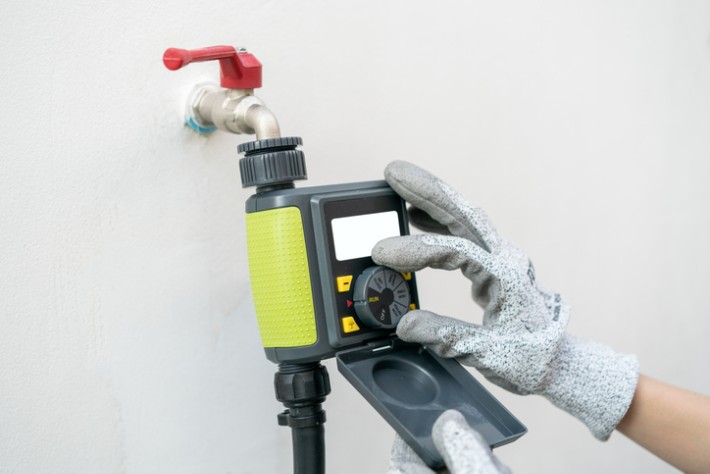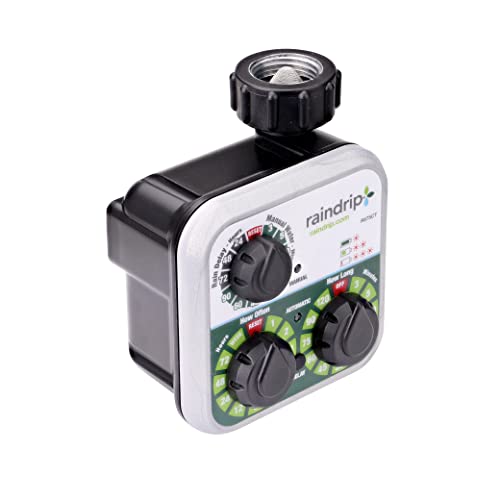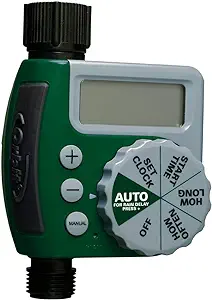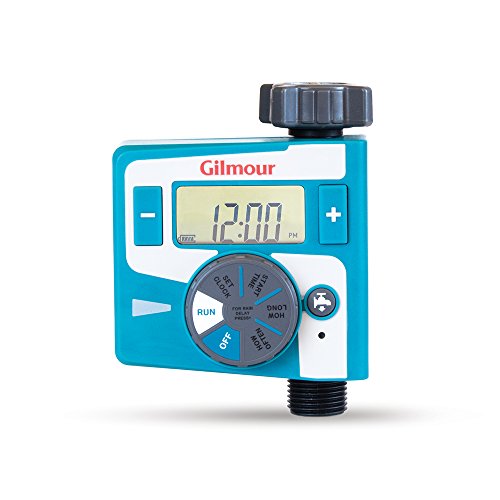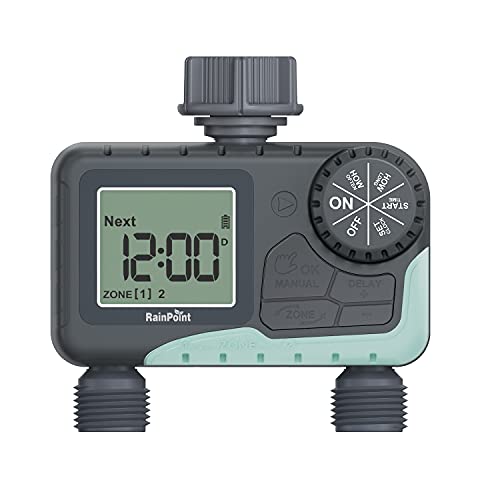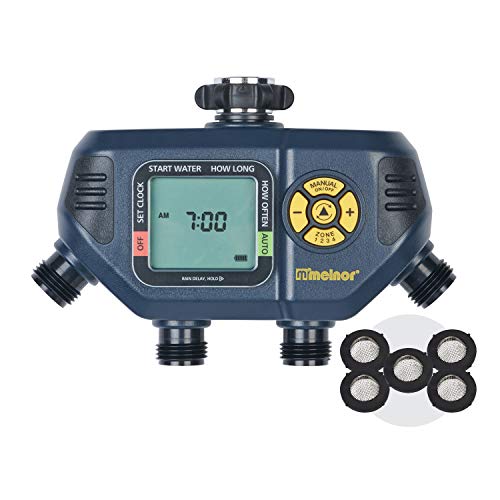- Flowers & PlantsVegetables
The Best Water Timers of 2024
Last updated: Mar 12, 2024
Revolutionize your watering routine with the precision and efficiency of water timers. These ingenious devices empower you to orchestrate your garden's hydration with unparalleled control. Imagine a world where your plants receive the perfect amount of water, precisely when they need it. Water timers make this vision a reality, offering programmable schedules and customization to suit your garden's unique needs. Say goodbye to over-watering or under-nourishing, as these timers ensure optimal moisture levels, promoting lush greenery and blooming beauty. Embrace the future of smart gardening with our favorite, the Raindrip 3-Dial Analogue Water Timer.
- Best Overall: Raindrip 3-Dial Analogue Water Timer Shop Now ➔
- Most Durable: Orbit Single-Outlet Water Timer Shop Now ➔
- Easy to Use: Gilmour Electronic Water Timer Shop Now ➔
- Most Features: RainPoint Programmable Water Timer Shop Now ➔
- Adjustable Option: Melnor Aqua Digital Water Timer Shop Now ➔
View all ContentsThe Best Water Timers
Best Overall
The RainDrip water timer is designed to allow homeowners to water their landscape efficiently and economically by scheduling watering times. The water timer can be attached to any outdoor faucet, standard drip tubing, or directly to the garden hose using an adaptor kit.
The unit clips onto the valve of your choice and measures water flow through the solenoid and diaphragm valves on/off control. The solenoid on/off control will turn off when the required PSI is reached or after the programmed duration. It also has automatic shut-off features that automatically turn it off when the battery becomes low. Plus, this timer does not require any tools for installation! Just place the unit’s body above your faucet, attach standard drip tubing to the hook-up spout, and insert two AA alkaline batteries into the unit. It’s that simple!
Pros
- Equipped with a low battery indicator
- Retains the watering schedule when batteries are replaced
- Can be attached to standard drip tubing or spigot
Cons
- Battery powered; batteries sold separately
Most Durable
This Orbit single outlet water timer enables the gardener to program the duration of outdoor watering. This water timer is constructed with heavy plastic material and metal hardware, ensuring durability in any weather. It also features a rain delay for increased water conservation during non-rainy periods and a manual override switch that allows programming flexibility for non-standard watering times.
This water timer enables you to program automatic watering up to six times per day or once every 7 days. With this water timer, you don’t have to worry about any particular outlets or complicated wiring. Just choose the timer setting and the days you want to water, and it will automatically turn on and off to provide healthy and even watering for your lawn or garden all season long.
Pros
- Manual override switch for programming flexibility
- Rain delay features to conserve water in the event of rain
- Durable plastic and metal construction for long term usage
Cons
- You have to manually turn off the valve to stop the water flow
Easy to Use
The Gilmour electronic water timer helps you water your lawn or garden at the most efficient time. This water timer can run on one hose at a time through its single outlet. The easy-to-use dial lets you program your watering schedule. The timer can easily be adjusted from 1 minute to 360 minutes by turning the dial clockwise to the desired cycle time.
Your time settings are displayed on the front screen, so you can easily see them even in low-light conditions. The programmable electronic timer automatically starts and stops water flow at any predetermined time, eliminating the need for manual watering. The timer has a metal swivel coupling for an easy leak-proof connection. Just attach it to your spigot or hose and start watering!
Pros
- Easy to use dial to program water schedule
- Metal swivel coupling that prevents leakage
- User Friendly
Cons
- Requires 2 AA batteries, which are not included in the package
Most Features
Water your garden, lawn, and other places precisely as you want with the Rainpoint water timer. The Rainpoint is a 2-outlet with a separate timed watering system. You can program each outlet to operate at your desired time. The LCD screen shows the watering time, watering frequency, power, and other detailed content. It has built-in metal filters that remove impurities and prevent leakage as well.
With it, you have manual control over the watering time – as short as 5 minutes or as long as 24 hours. This water timer has three modes: rain delay, manual, and auto watering system. All these modes automatically adjust the water timing, which also helps to save water. This timer will make your life much more convenient and let you work according to the schedule without worrying too much about watering while you are away from home.
Pros
- Three different modes to adjust water timing
- Two valve outlet for separate water cycles
- Built-in metal filters to remove impurities
Cons
- Internal couplings of the timer are not strong enough to prevent leakage
Adjustable Option
The Melnor Aqua digital water timer makes watering tasks easy for you. This easy-to-program watering timer lets you run up to four valves at a time and allows you to water your yard at any time of the day. This water timer has a clear digital readout window that displays the amount of time left before the next cycle begins. A built-in manual override lets you water your lawn up to 24 hours a day, any day of the week – making sure your yard gets what it needs!
The 5-filter washer allows you to add backwash at any time, making it easy to clean out debris from sprinklers and valves so they work correctly. The adjustable rain delay feature allows it to conserve water by automatically shutting off irrigation for rain or watering events. It will restart the cycle once the rain stops. This product is also backed by a 7-year manufacturer’s warranty.
Pros
- Five filter washers to clean out debris from the valves
- Adjustable rain relay features to prevent overwatering during the rainy season
- Quad valves with multi-zone capability
Cons
- Difficult to operate
Finding a High-Quality Water Timer: A Buying Guide
If you want to water plants regularly but don’t have the time, you’ll likely find yourself turning to a water timer. There are plenty of options available in the market, so, how do you choose one? In this guide, we will help you figure out which irrigation system is best for your needs. We’ll also talk about how these timers work, their benefits, how they can save time, and more!
What Is a Water Timer?
A water timer is a device that connects to a water source, such as the faucet on your house, and automatically controls the irrigation of your garden. They range from simple timers that can be set to a basic watering schedule and water once or twice a day to more complex systems that will water every few days for up to two weeks. Some timers even have data reporting and smartphone apps so you can see how much water your plants need and make adjustments as needed. With the proper garden timer, you can reduce your watering duration and save money on your utility bills too.
If you’re interested in learning how a hose timer works, you can watch this video from Julian Ilett:
Types of Water Timers
A hose timer is a great way to save the time and hassle of watering your garden. There are different types of hose timers, but all of them work on the same principle.
Mechanical
A mechanical timer is old technology but is still widely used. These timers consist of a faucet, spout, or other water source connected to a mechanical timer, which dispenses water according to a user-specified schedule. They are considerably cheaper than digital timers, and installation is rarely required.
The disadvantages of mechanical timers are less clear-cut. Because they rely on a faucet, they can malfunction if the water pressure drops or the temperature fluctuates.
Digital
A digital hose timer, on the other hand, is a compact and battery-operated timer. It fits inside a small box. You simply set the timer, plug it into an electrical socket, and that’s it. It has preset schedules and can also control watering based on humidity levels. It also allows you to add multiple watering cycles.
There are some disadvantages of digital hose timers. For example, you have to replace them every year, and they require electricity to operate.
Features To Look for When Buying a Water Timer
Number of valve outlets
Timers with multiple water valve outlets allow you to program watering times for more than one section of your garden. For example, you may have one area that needs more watering during the winter and another section prone to fungus and needs extra watering in the summer. With a separate water valve outlet, you can set different watering times for these sections.
Multiple water durations
Another thing you might want to notice is the watering duration. These water intervals can range anywhere from a few minutes to several hours depending on your needs. This feature is especially beneficial with multiple outlets where you want to water a specific part of the garden for 15 minutes and another for 30 minutes. With multiple water durations, you can set the timer for once a day or twice every week.
Rain delay feature
Before buying a hose timer, make sure it has a rain delay feature. The benefits of a rain delay feature are numerous. Unlike soil moisture sensors, which usually detect moisture levels in the soil, rain delay features detect rain events and adjust the watering schedule based on that weather.
You will no longer have to worry about a rainstorm ruining your landscaping or that your plants won’t get watered. This is especially handy if you’re away on vacation.
Manual timing feature
Although the hose timer automates the watering schedule, it doesn’t mean that you can’t set manual watering cycles. Some mechanical hose timers allow you to manually set the desired time according to your garden’s needs. Opt for a hose timer that automates the watering but allows you to set the desired time limit manually.
Waterproof construction
While buying a hose timer, make sure it is made of high-quality copper or plastic, which is waterproof and rust-resistant. Some digital models are not waterproof. With those models, the water can enter the battery access port resulting in damaging the water timer. On the other hand, you won’t have to face this issue with a mechanical hose timer.
LCD display
With the advancement in technology, many hose timers are now equipped with LCD displays. The LCD screen gives you the convenience of setting an accurate watering time. It can be programmed for manual or automatic watering. It also shows the current and remaining watering time. While it may seem complicated, it’s not. If you still find it a little difficult to use, you can choose a basic model with a dial. Just turn the dial and set the desired timing.
Some irrigation system models have additional buttons for adjusting the water’s flow rate or for turning on the system.
Water Timer Price Range
hose timers can vary widely in price. Some timers cost as little as $20, while others cost hundreds of dollars. On average, water timers cost between $20-$70. The prices for hose timers are based on brand, size, number of zones, and level of functionality.
For example, some timers only shut off one zone, while expensive models can shut off multiple time zones. If you’re willing to spend a little more, you can get a more expensive model that allows you to program the watering cycle in intervals of 24 hours, 12 hours, and 6 hours.
People Also Asked
Can you use any other batteries in a water timer besides alkaline batteries?
Yes, you can. Just replace the batteries with lithium batteries, and your water timer will work just fine.
How much PSI does the water timer need to operate efficiently?
Almost all water timers require a minimum of 8 PSI to operate correctly. Some models work with 3 PSI, which is relatively low and affects the sprinkler’s performance and waste water. You can get a water flow meter or gauge to check the water pressure and then buy a water timer accordingly.
Why does my water timer keep turning on automatically?
When the valve gets stuck in the open position, the water keeps on running through the line, which disrupts the water timing duration and the timer keeps turning on automatically. Try to change the valve to fix this issue.
Article Contributors
Read More About Garden Gate Review Team HereThe Garden Gate Review Team’s product reviews and in-depth guides are here to help you choose the best products for a beautiful and bountiful garden and backyard. The content is created by The Garden Gate Review Team. Garden Gate’s editorial staff is not involved. Garden Gate is reader-supported: When you buy through links on our site, we may earn an affiliate commission. The Garden Gate Review Team is composed of authors, editors, and gardeners. Artificial Intelligence (large language models) may have been used in the research and creation of the content.
Please reach out to aimperiapt@gmail.com with any questions regarding product testing or specific articles.
